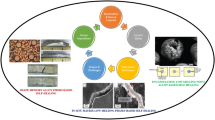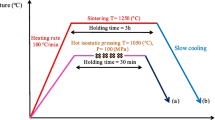Abstract
To apply the dental Co-Cr-Mo-W alloy restorations fabricated by selective laser melting to clinical use cases, it is necessary to perform a subsequent heat treatment (HT) after SLM processing. However, investigations regarding the effects of HT temperatures on microstructures and mechanical properties inherent in SLM-manufactured Co-Cr-Mo-W alloys are still insufficient. In this article, the microstructure variation during HT at different temperatures and its effect on mechanical properties were systematically investigated and discussed. The Co-Cr-Mo-W dental alloys fabricated by SLM were heat treated at 750 °C, 850 °C, 950 °C, 1050 °C, and 1150 °C for 1 hour and subsequently air cooled. Then, the microstructures were characterized and the mechanical properties evaluated. The results showed that, during HT, Co3(Mo, W)2Si intermetallic compounds with hcp crystal structures precipitated in specimen matrixes and at grain boundaries. With heat treatment temperatures increasing from 750 °C to 950 °C, the number of precipitates gradually increased, and the volume gradually grew. When the temperature increased to ≥ 1050 °C, the number of intermetallic compounds decreased. On the other hand, with increasing HT temperatures, the content of ε-Co phases increased initially but then dropped, reaching a maximum of 97.5 pct at 950 °C and a minimum of 4.4 pct at 1150 °C. Furthermore, there is a coherent relationship between hcp phases (ε-Co) and fcc phases (γ-Co), and the two lattice cells allow the relative orientation of {0001}ε//{111}γ, 〈11-20〉ε //〈110〉γ. Mechanical test results showed that, with increasing HT temperatures, the 0.2 pct yield strength (0.2 pctYS) and ultimate tensile strength (UTS) increased initially and then dropped, reaching a maximum value at 850 °C. Conversely, the ductility decreased initially and then rose, reaching a minimum at 850 °C and 950 °C. The mechanical properties depended primarily on the change of volume fractions of the ε-Co in mixture as well as the size, morphology, and distribution of precipitates. Additionally, specimens heat-treated at 1050 °C for 1 hour were superior to as-SLM (AS) specimens in both strength and ductility.








Similar content being viewed by others
References
B. Vandenbroucke and J. Kruth, Rapid prototyping j., 2007, vol. 13, pp. 196-203.
B. Qian, K. Saeidi and L. Kvetková, Dent. Mater., 2015, vol. 31, pp. 1435-1444.
Yamanaka K., Mori M., Koizumi Y. and Chiba A., J. Mech. Behav. Biomed. Mater., 2014, vol. 32, pp. 52–61.
A. Marti, Injury, 2000, vol. 31, pp. 18-21.
A. Karaali, K. Mirouh, S. Hamamda, and P. Guiraldenq, Comp. Mater. Sci., 2005, vol. 33, pp. 37-43.
D. Myszka, and M. Skrodzki, Arch. Foundry Eng., 2016, vol. 16, pp. 201-207.
Y. Ucar, T. Akova, M.S. Akyil and W.A. Brantley, J. Prosthet. Dent., 2009, vol. 102, pp. 253–259.
N. Xiang, X. Xin, J. Chen, and B. Wei, J. Dent., 2012, vol. 40, pp. 453-457.
X. Xin, J. Chen, N. Xiang, Y. Gong, and B. Wei, Dent. Mater., 2014, vol. 30, pp. 263-270.
Koutsoukis T., Zinelis S., Eliades G., Al-Wazzan K., Al-Rifaily M. and Jabbari Y.S., J. Prosth., 2015, vol. 24, pp. 303–312.
Y. Lu, S. Wu, Y. Gan, S. Zhang, S. Guo, J. Lin, and J. Lin, J. Mech. Behav. Biomed. Mater., 2016, vol. 55, pp. 179-190.
Zhou X., Li K. and Zhang D., J. Alloy Compd., 2015, vol. 631, pp. 153-164.
Y. Hed-berg, I. Odnevall-Wallinder, J. Biomed. Mater. Res., 2014, vol. 102, pp. 693–699.
X. Xian-zhen, X. Nan, C. Jie, X. Dan, and W. Bin, J. Mater. Sci. 2012, vol. 47, pp. 13-20.
W. Wei, Y. Zhou, W. Liu, N. Li, J. Yan, and H. Li, J. Mater. Eng. Perform., 2018, vol. 27, pp. 5312-5320.
Takaichi A., Nakamoto T., J. Mech. Behav. Biomed. Mater., 2013, vol. 21, pp. 67-76.
Lu Y., Wu S., Gan Y., Li J., Zhao C., Zhuo D., Mater. Sci. Eng. C, 2015, vol. 49, pp. 517-525.
Y. Zhou, W. Wei, J. Yan, W. Liu, N. Li, H. Li, and S. Xu, Mater. Sci. Eng. A, 2019, vol. 759, pp. 594-602.
W.E. Frazier, J. Mater. Eng. Perform., 2014, vol. 23, pp. 1917–1928.
M. Zhang, Y. Yang, C. Song, Y. Bai, and Z. Xiao, J. Alloy Compound, 2018, vol. 750, pp. 878-886.
Y. Kajima, A. Takaichi, N. Kittikundecha, T. Nakamoto, T. Kimura, N. Nomura, A. Kawasaki, T. Hanawa, H. Takahashi, and N. Wakabayashi, Mater. Sci. Eng. A, 2018, vol. 726, pp. 21-31.
P. Mengucci, G. Barucca, A. Gatto, E. Bassoli, L. Denti, F. Fiori, E. Girardin, P. Bastianoni, B. Rutkowski, and A. Czyrska-Filemonowicz, J. Mech. Behav. Biomed. Mater., 2016, vol. 60, pp. 106-117.
C. Balagna, S. Spriano, and M.G. Faga, Mater. Sci. Eng. C, 2012, vol. 32, pp. 1868-1877.
H. R. Lashgari, S. Zangeneh, F. Hasanabadi, and M.Saghafi. Mater. Sci. Eng. A, 2010, vol. 527, pp. 4082-4091.
M. Mori, K. Yamanaka and A. Chiba, J. Alloy Compound, 2014, vol. 590, pp. 411-416.
C. Montero-Ocampo, R. Juarez, A.S. Rodriguez, Metall. Mater. Trans. A, 2002, vol. 33, pp. 2229-2235.
K. Yoda, A. Takaichi, N. Nomura, Y. Tsutsumi, H. Doi, S. Kurosu, A. Chiba, Y. Igarashi, and T. Hanawa, Acta Biomater., 2012, vol. 8, pp. 2856-62.
S.H. Lee, N. Nomura and A. Chiba, Mater. Trans., 2007, vol. 48, pp. 2207–2211.
K. Yamanaka, M. Mori and A. Chiba, Mater. Sci. Eng. A, 2011, vol. 528, pp. 5961–5966.
Acknowledgment
This work was supported by the National Natural Science Foundation of China (No. 21575137).
Author information
Authors and Affiliations
Corresponding author
Additional information
Publisher's Note
Springer Nature remains neutral with regard to jurisdictional claims in published maps and institutional affiliations.
Manuscript submitted October 8, 2019.
Rights and permissions
About this article
Cite this article
Wei, W., Zhou, Y., Sun, Q. et al. Microstructures and Mechanical Properties of Dental Co-Cr-Mo-W Alloys Fabricated by Selective Laser Melting at Different Subsequent Heat Treatment Temperatures. Metall Mater Trans A 51, 3205–3214 (2020). https://doi.org/10.1007/s11661-020-05719-y
Received:
Published:
Issue Date:
DOI: https://doi.org/10.1007/s11661-020-05719-y




